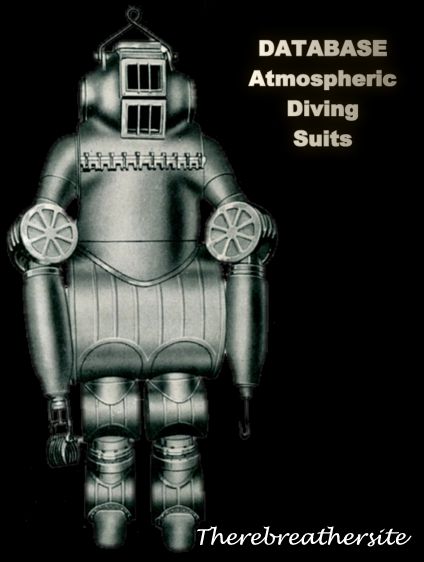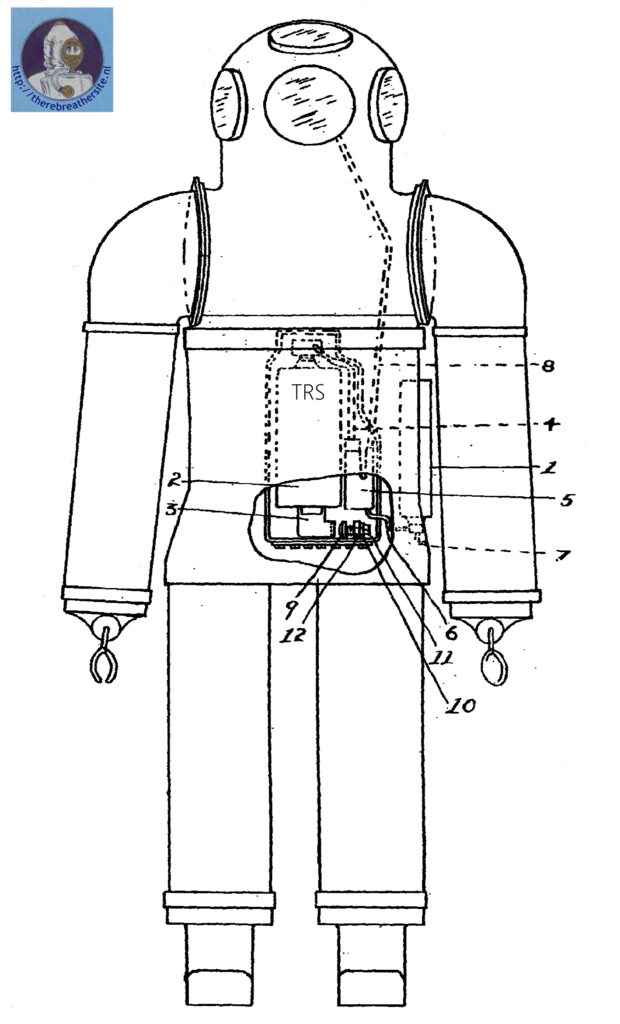
In 1918 William John Mellersh-Jackson filed a patent application working at Haseltine Lake & Co in London for the Leavitt Company USA for a breathing system to be used in atmospheric diving suits.The oxygen rebreather in question was novel in that the invention provided a solution to the risk of gas release that occurs when water comes into contact with caustic soda. At that time, the carbon dioxide and water vapour in the atmospheric suits were passed through a scrubber containing caustic soda. If this came into contact with water, it produced vapours that could be fatal to the diver. By building the scrubber in a cassette and fitting it with a valve that closes off when water is intruded, the formation of these gases could be prevented. In how far the diver would not be bothered by the filling up of the suit was not explained in this patent.

Here the patent description text of Mellersh-Jackson:
Having now particularly described and ascertained the nature of the said invention, and -in what manner the same is to be performed, as communicated to me by my foreign correspondents, I declare that what I claim is:-
1. In an oxygen apparatus for divers, the combination with a diving armor, of a tank for receiving caustic soda or other material capable of absorbing carbonic acid gas and moisture said tank having an inlet and an outlet in communication with said armor, means for replenishing the oxygen consumed by the diver, a closure for the inlet of the chemical tank, and mechanical means for automatically seating said closure upon a rise of water within the armor to a predetermined level.
2. In an oxygen apparatus for divers, the combination with a diving armor including body and helmet sections, of a tank for receiving caustic soda or other materialcapable of absorbing carbonic acid gas and moisture having an inlet in communication with the body section and having an outlet, a pipe communicating with said outlet and discharging in the helmet section, means for replenishing the oxygen consumed by the diver, a closure for said inlet, and mechanical -mei;ns for automatically seating said closure upon a rise of water within the armor to a predetermined level.
3. In an oxygen apparatus for divers, the combination with a diving armor, of a tank for receiving caustic soda or other material capable of absorbing carbonic acid gas and moisture having an inlet and an outlet in communication with said armor, means for replenishing the oxygen consumed by the diver, a closure for the inlet of said tank, mechanical means acting on said closure tending to seat the same, and a soluble body opposing the last-named means whereby said closure will seat upon a rise of water within the armor to the level of said soluble body.
4. In an oxygen apparatus for divers, the combination with a diving armor, of a tank for receiving caustic soda or other material capable of absorbing carbonic acid gas and moisture carried by said armor and having communication therewith, means for replenishing the oxygen consumed by the diver, a closure for cutting off communication between the armor and said tank, a stem for said closure, a guide for said stem, a spring acting upon the closure tending to seat the same, and a soluble body interposed between said guide, and a shoulder on said stem opposing said spring whereby a rise of water within the armor to the level of said soluble body will automatically seat said closure.

Therebreathersite was founded by Jan Willem Bech in 1999. After a diving career of many years, he decided to start technical diving in 1999. He immediately noticed that at that time there was almost no website that contained the history of closed breathing systems. The start for the website led to a huge collection that offered about 1,300 pages of information until 2019. In 2019, a fresh start was made with the website now freely available online for everyone. Therebreathersite is a source of information for divers, researchers, technicians and students. I hope you enjoy browsing the content!
